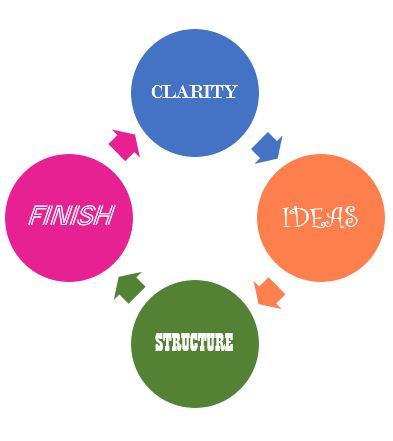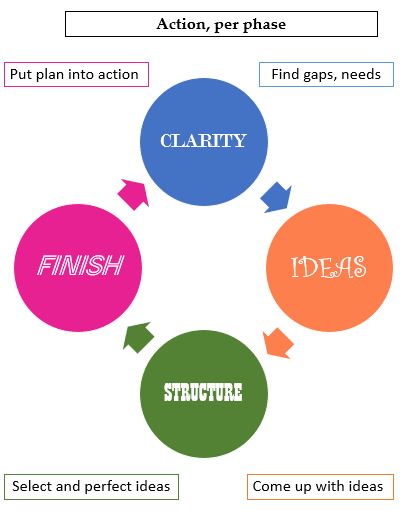Crazy Concept. Do We All Create Alike?
How could it be that Michelangelo created in the same way as, say Andy Warhol?

Or imagine saying that Shakespeare wrote with the same thought process as Dr. Seuss.

As vastly different as these artists’ creations and eras are, they have a common thread in their creative process. Since 1950, scientists from psychology, biology and neurology, have focused their experimentation, research and work to fully understand how human minds create.
They have defined a universality to the thinking process that has come to be called Deliberate Creativity, or Creative Problem Solving and it identifies the order in which our thoughts and problem solving occur when creativity is happening.
Deliberate Creativity
Deliberate Creativity is a model of the Creative Thinking Process that represents 75+ years of scientific research into creative thinking. This is how your brain works when you’re writing, painting, or making a first-rate soup.
Why You Need to Know This
Once you understand Deliberate Creativity, your creative process is much more predictable – even if your ideas are original and wild. You can tweak your expectations and eliminate much of the frustration you feel and the negative inner voices you hear as you shift from one phase of creativity to another.
You can master clarity, get better and more exciting ideas, finish your work, and get things out into the world effectively. Does that sound good?
What’s holding you back?
- Most people think that creativity is unknowable and ideas come from “somewhere.”
While there is still magic to creativity, the creative process is well-defined and understood. Self-knowledge is power over self. Your brain will still roam free for its creative brilliance, but you’ll understand where it’s headed next and what you might do to ease into that transition. - We fear that awareness of the “process” will ruin creativity, destroy our mojo.
If you’re crushing it – then don’t fix what ain’t broke. But most of us get stalled or stopped sometimes, and a map of the process might be just what you need to get started in the right direction again. - We think it’s all our fault.
We think that is our own weakness, failure, lack of creativity, discipline or talent. In fact, we don’t even think there’s help for writers who aren’t writing. (There is.)
The Creative Thinking Process
What You Need to Know

This Creative Thinking Process is at work every time, and if the process is interrupted or marred, creativity is itself interrupted or marred. When we’re stuck in a phase, we call it “writers’ block.” When we’re limping through to finished – skipping or skimping a phase – we call it “a big flop.”
This is the model of Creative Thinking – or how to create deliberately. This is based on the work and model of Dr. Gerard Puccio, Chairperson of the International Center for Studies in Creativity at Buffalo State College, also known as the FourSight model.
When we create successfully, we spend time in each of these phases:

- Clarity – we identify specific challenges – how to research, how to develop the characters, what time period, what the story needs. This is a phase in which we delve into all the questions that need asking, and then we step back and determine what is important, pressing, relevant.
- Ideas – Having selected a challenge, we come up with ideas for achieving that challenge. For writers, that challenge can be as large as – What needs writing? Where do I want to explore? – and as small as – How should I resolve this scene? What might be the title of this work?
- Structure – This is the real “work” phase. You have your ideas. You select the best ideas, and perfect them, and structure them into the product.
- Finish – In this phase, you get the work out of your head, out of development and into its final form – whether that’s written, polished, published, produced, promoted, or shipped.
What Else You Need to Know
This is the Creative Thinking Process. And when creativity is working, this fundamental thinking process – in all its phases – are at work underneath the surface. Conscious or not, this is how successful creators think as they get their work completed and shared.
- from J.K. Rowling (Harry Potter) to Margaret Atwood (A Handmaid’s Tale)
- from Elizabeth Gilbert (Eat, Pray, Love) to Elizabeth Strout (Olive Kitteridge)
- from Mike Meyer (Austin Powers) to Tina Fey (30 Rock)
- from Sheryl Sandburg (Lean In) to Dolly Parton (Working 9 to 5)
If they’re unconsciously using the same thinking process, then how do they come up with such different results? It’s interesting. Each of us uses this route, predictably, to get from A to Z. And yet we each use it differently.
Because of our inherent skills, preferences, temperaments or talents we take the same mental path, very differently.
We speed through some phases, because 1) we’re really good at it or 2) we hate it and give it short shrift.
We stall and languish in some phases, again, either because 1) we’re really good at it and we love it, or 2) we hate it. We’re no good at it, and we pretend we don’t have to do that phase.
It is extremely useful to know your own thinking style preferences and be able to predict when you’re going to detour, or rush through a critical phase, giving your creative product short shrift. Furthermore there are numerous tools available to help the poor writer who hates a particular phase (but still has to do it.)
My Story (and Why I Care)
I got my Masters in Science in Creative Studies, a branch of Psychology. I chose that course of study because I still couldn’t figure out my own creativity. I knew I was highly creative and original because, I’d been a professional and sought-after brainstormer for most of my working life.
But, I couldn’t for the life of me figure out – for lack of a better metaphor – how to drive this dang thing. I came up with lots of ideas, but why wasn’t I writing novels? Writing comedy scripts? Doing great things?
My creative strong suit is ideation. I’m a very fluent and original ideator. I know this from my professional experience, and also from my creativity assessment results. Since I had many, many, exciting ideas, it was hard for me to pick one and stick with it.
What I didn’t know about myself was that I’m a very poor clarifier, if left to my own devices. I’d like an idea and I’d begin. Something would go wrong and three months later… oh well, I have more ideas where that came from. I’d jump from idea to idea, mostly because I never clarified what I wanted to achieve with my brilliant ideas. Knowing I had a distaste (and low level of inherent skill) for Clarifying, pointed me in the right direction. I began using tools to help me clarify, effectively. I stopped wondering about my creativity and began wielding it!
I went from chasing my tail, creatively speaking, to going in a straight line, moving forward, building this business. One idea building on the last.
Recap
We all create the same – using the same path – in our own idiosyncratic ways. When each of us can see our talents for what they really are, and tweak our troubles to be less limiting, we can do our best, most essential work. And that’s why I care… enormously.
This information, about how creative thinking works, has been available for over 40 years. Most of my classmates took this information into the business world of innovation. I could have done that too. But for me, it has become urgent and relevant to help individual creators – especially writers – to understand and use this knowledge to do their best work. Can you see a phase where you truly excel? Can you see a phase where you likely break down? That’s a very good start.